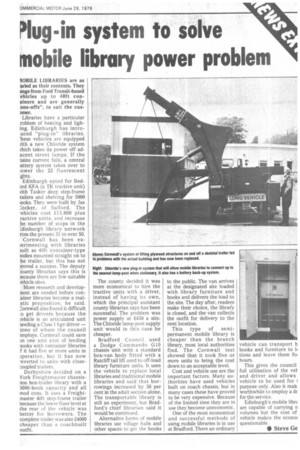Plug-in system to solve mobile library power problem
Page 29

If you've noticed an error in this article please click here to report it so we can fix it.
1OBILE LIBRARIES are as aried as their contents. They ange from Ford Transit-based ehicles up to 40ft conainers and are generally one-offs", to suit the cuspmer.
Libraries have a particular roblem of heating and ligh ing. Edinburgh has intro uced "plug-in" libraries. 'hese vehicles are equipped Ath a new Chloride system vhich takes its power off adacent street lamps. If the ruins current fails, a central lattery system takes over to lower the 22 fluorescent [ghts.
Edinburgh opted for Bedord KFA (a TK tractive unit) vith Tasker deep step-frame railers and shelving for 5000 wioks. They were built by Jas :.ocker, of Salford. The rehicles cost £13,600 plus ractive units, and increase he number of stops in the F.dinburgh library network rom the present 31 to over 50.
Cornwall has been exwrimenting with libraries )uilt as 40ft container-type xxlies mounted straight on to he trailer, but this has not >roved a success. The deputy ounty librarian says this is )ecause there are few suitable fehicle sites.
More research and developnent are needed before con ziner libraries become a real stic proposition, he said. 2,ornwall also found it difficult :o get drivers because the vehicle is an articulated unit leeding a Class 1 hgv driver — lone of whom the council .mploys. Cornwall could save 311 one unit cost of lending books with container libraries .f it had five or more units in Dperation, but it has now 'everted to units with closecoupled trailers.
Derbyshire decided on a York Freightmaster chassis less box-trailer library with a 5000-book capacity and all mod cons. It uses a Freight master 40ft step-frame trailer because the lower floor level at the rear of the vehicle was better for borrowers. The complete trailer was also £4000 cheaper than a coachbuilt outfit. The county decided it was more economical to hire the tractive units with a driver, instead of having its own, which the principal assistant county librarian says has been successful. The problem was power supply at £450 a site. The Chloride lamp-post supply unit would in this case be cheaper.
Bradford Council used a Dodge Commando G10 chassis unit with a standard box-van body fitted with a Ratcliff tail lift used to off-load library furniture units. It uses the vehicle to replace local libraries and traditional mobile libraries and said that borrowings increased by 50 per cent in the adult section alone. The transportable library is still an experiment, but Bradford's chief librarian said it would be continued.
Alternative forms of mobile libraries use village halls and other spaces to get the books to the public. The van arrives at the designated site loaded with library furniture and books and delivers the load to the site. The day after, readers make their choice, the librardy is closed, and the van collects the outfit for delivery to the next location.
This type of semipermanent mobile library is cheaper than the branch library, most local authorities find. The Cornwall test showed that it took five or more units to bring the cost down to an acceptable level.
Cost and vehicle use are the important factors. Many authorities have used vehicles built on coach chassis, but in many cases these have proved to be very expensive. Because of the limited time they are in use they become uneconomic.
One of the most economical and successful methods of using mobile libraries is in use at Bradford. There an ordinary vehicle can transport b books and furniture to N tions and leave them fa hours.
This gives the council full utilisation of the vet and driver and allows vehicle to be used for I purpose only. Also it mak worthwhile to employ a dr for the service.
Edinburgh's mobile librE are capable of carrying n volumes but the cost of vehicle makes the econoi questionable.
• Steve Ge
































































































































